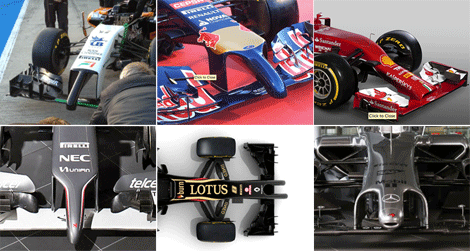
Interesting design changes in F1 this season have seen some eye-catching front end designs
There’s something unsettling about the F1 cars lining up for the 2014 season – and it’s all about the aerodynamic appearance.
‘The broken nose’. ‘The anteater’. ‘The dildo’. ‘The double-dildo’ (see the new Lotus): The 2014 cars in this million dollar sport have front ends like the patients of a dodgy, backstreet rhinoplasty clinic.
As teams strive to keep the front end of the car as ‘clean’ as possible, the aim is to force as much air under the front wing to increase the available downforce.

The Torro Rosso 2014 F1 car shows its phallic front-end
The 2014 cars come with a whole swathe of changes, most of which centre around the new 1.6litre turbo-charged V6, having dropped the old V8, but its the aero regulations caused by this change of engine that is grabbing the headlines.
It goes to prove that almost everything in F1 design has a knock-on effect. With a turbo now being accommodated in the power unit, the vehicle’s cooling and ventilation needs have meant a complete aero redesign for most teams.
The majority of this design is now done using vast amounts of 3D CAD simulation – as we saw last year with Caterham F1 as they began to prepare for this year’s car – as well as with 3/4 scale models in wind tunnel testing.
The designs are already proving conscientious on the track – Mercedes have already had Lewis Hamilton total a car thanks to a front wing ‘failure’.
Red Bull’s design guru Adrian Newey is worried about cars ‘torpedoing’ one another in a crash situation due to the low nose positioning, despite the nose rule being introduced for safety to stop cars from lifting off behind another car.
This type of mass overhaul in F1 design comes only once every few seasons, so like many we’re hoping it will be a season where design overshadows driver, even if only by a nose.
These race-honed cars will never be about aesthetics, yet some classic models hold a place in the heart, such as the beautiful 1950s Maserati 250F.







